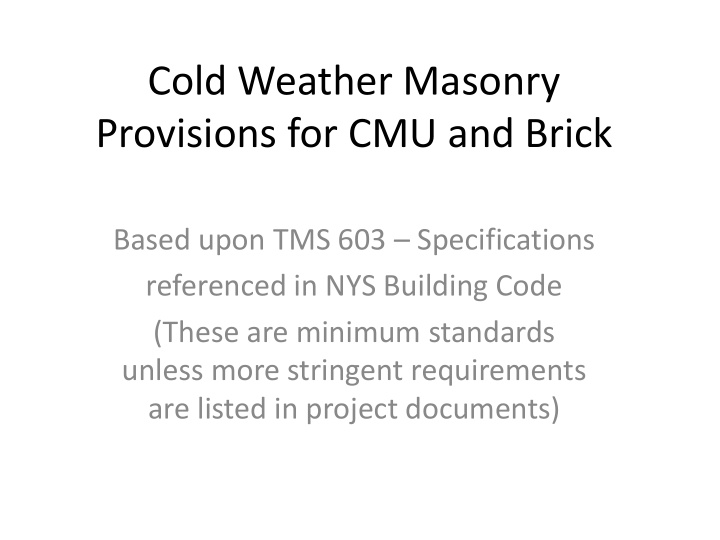



Cold Weather Masonry Provisions for CMU and Brick Based upon TMS 603 – Specifications referenced in NYS Building Code (These are minimum standards unless more stringent requirements are listed in project documents)
Temperatures • Ambient: air temperature of the environment at any given time. • For cold weather, need to deal with low temperatures. • Cold Weather criteria starts when ambient air temperature is below 40°F.
Key Issues to Consider • Condition of foundations and existing masonry prior to starting each day. • Condition of materials prior to starting each day. • Ambient temperature while you are constructing any masonry. • Ambient temperature when you are protecting the construction.
Daily Process First check Foundations and Existing Masonry, then: Materials Construction Protection
Foundations and Existing Masonry Remove visible ice and snow from the top surface of existing foundations and masonry to receive new construction. Heat these surfaces above freezing, using methods that do not result in damage.
Materials Do not lay masonry units having either a temperature below 20°F or containing frozen moisture, visible ice, or snow on their surface.
Construction ambient temperatures: below 40°F to 32°F 1) Heat sand or mixing water to produce mortar temperature between 40°F and 120°F at the time of mixing. 2) Heat grout materials when the temperature of the materials is below 32°F.
Caution • Do not heat water or aggregates used in mortar or grout above 140 ° F.
Construction ambient temperatures: below 32°F to 25°F 1) Heat sand and mixing water to produce mortar temperature between 40°F and 120°F at the time of mixing. Maintain mortar temperature above freezing until used in masonry. 2) Heat grout aggregates and mixing water to produce grout temperature between 70°F and 120°F at the time of mixing. Maintain grout temperature above 70°at the time of grout placement.
Construction ambient temperatures: below 25°F to 20°F 1) Heat masonry surfaces under construction to a minimum temperature of 40°F. 2) Use wind breaks or enclosures when the wind velocity exceeds 15 mph. 3) Heat masonry to a minimum temperature of 40°F prior to grouting.
Construction ambient temperatures: below 20°F 1) Heat masonry surfaces under construction to a minimum temperature of 40°F. 2) Use wind breaks or enclosures when the wind velocity exceeds 15 mph. 3) Heat masonry to a minimum temperature of 40°F prior to grouting. 4) Provide an enclosure and auxiliary heat to maintain air temperature above 32°F within the enclosure.
Protection ambient temperatures: below 40°F to 25°F Protect newly constructed masonry by covering with a weather-resistive membrane for 24 hr after being completed.
Protection ambient temperatures: below 25°F to 20°F 1) Cover newly constructed masonry completely with weather-resistive insulating blankets, or equal protection, for 24 hr after completion of work. 2) Extend time period to 48 hr for grouted masonry, unless the only cement in the grout is Type III portland cement.
Protection ambient temperatures: below 20°F 1) Maintain newly constructed masonry temperature above 32°F for at least 24 hr after being completed by using heated enclosures, electric heating blankets, infrared lamps, or other acceptable methods. 2) Extend time period to 48 hr for grouted masonry, unless the only cement in the grout is Type III portland cement.
Example – Project Startup Overnight temperature was a low of 20°F. CMU temperature is 22°F and ice is visible on the units. During the day, temperatures will be 30°F to 40°F. For next overnight, temps drop to 15°F. What can/should you do? 1. Foundation 2. Materials 3. Construction 4. Protection
Example 1 – Project Startup Big issue: Ice is visible on the units. 1. Foundations Raise foundation temp above freezing. 2. Materials NG ..units have ice. Can’t construct with these units until units are warmed to remove ice. 3. Construction 4. Protection
Example 2 – Daily Work Construction occurs during the day when air temperatures starts at 25°F will rise up to 40°F. CMU temperature is 34°F at start. Overnight temps are expected to drop to 18°F. 1. Existing construction Check and heat as needed 2. Materials OK units above 20°F. no ice 3. Construction Adjust construction to changing temps or use criteria for 25°F construction throughout the day 4. Protection Use protection criteria for below 20°F
Recommend
More recommend